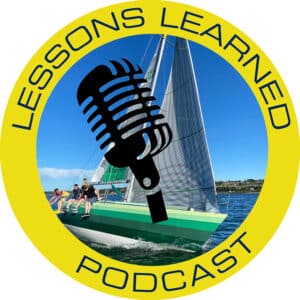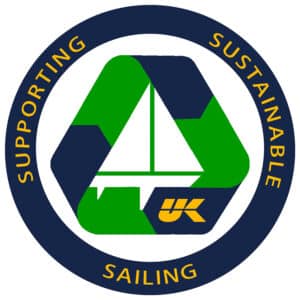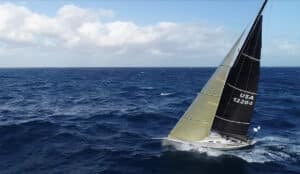The Swan 36 FINOLA (GBR 23806) and the S&S 41 WINSOME (NED 118) on the starting line of the 2019 RORC Channel Race.
By Graham Curran, UK Sailmakers Ireland
Walking through the Arrivals gates at Dublin Airport after the weekends’ RORC Channel Race, I was going through the events of the previous day and night. I sailed aboard Chris Frost’s Swan 36 FINOLA in preparation for our Fastnet Race starting next weekend.
We crossed the line at 0800 on Sunday morning after 23 hours of racing – finishing 2nd in IRC 4 about four minutes behind the winner, Harry Heijst’s S&S 41 WINSOME, also powered by UK Sailmakers. As is usually the chase when finishing second; I went through the race in my head to find where we could have gained those four minutes of corrected time. There were several occasions where there were gains to be had or losses that could have been avoided; but there is one in particular which we found interesting.
Critical Sail Selection
At 0200 on Sunday morning, we were in the last 40-mile stretch of our course – approaching the Owers turning mark before heading back for the Solent. We had been flying our S2 spinnaker (symmetrical runner) since the start of this long downwind leg in 12-15 knots of breeze. As we rounded St Catherine’s point and made our way to Owers the breeze began to steadily shift to the right; making our sailing angle tighter and tighter.
Eventually, we ended up tight reaching with our pole just off the forestay; our speedo was reading 6.8 – 7.5 knots, there was significant load on the helm, and a lot of active mainsheet trimming was needed to keep the boat on her feet. Something needed to change. FINOLA’s set-up left us with three options: continue as we were, unfurl our 145% overlapping genoa and set up on an outboard lead, or change to our Code Zero.
Our decision was to drop the spinnaker, unfurl our genoa, set up an outboard lead, and then consider launching our Code Zero after evaluating the situation. As always, the lads on the bow played a blinder; the drop and swap went perfectly without issue. We gave ourselves ten minutes to settle down and evaluate the situation. We found the boat was much easier to handle with little or no undue pressure on the helm; but our speed was down to 6.0 knots – time to try the Code Zero. After a short period, we had the Code Zero flying and genoa furled; FINOLA was cruising along at 6.8 to 7.5 knots again. This was the same speed that we were making with our spinnaker, but the difference in the boat’s behavior was dramatic — no significant heel and a wonderfully balanced helm.
The Lift and Drag Compromise
Life is all about compromise. Sailing is no different. Where there is lift, there is drag. Our goal as sailors is to maximize and harness lift while minimizing resulting drag. Lift gives us the power to move forward, above and below the water. Drag is what slows us down, usually manifesting itself as heel and stall. So how does this tie in with the rest of the story?
Drag Bad, Lift Good
Let’s keep it simple, primal as it were – down to caveman style “drag bad … lift good.” When we were reaching with our spinnaker, we had plenty of lift. The boat was moving through the water at hull speed or above it. We had all the lift we needed. The problem was that the spinnaker was causing too much drag, which manifested itself as heeling moment. To keep the boat on her toes we needed to use a lot of rudder and ease the mainsheet. More rudder means more drag below the waterline – slowing the boat as a result. All of this made the crew work much harder than is needed at 2 a.m. in the morning.
This is not the spinnaker’s fault. A running spinnaker will simply, by design, not reach effectively. It has a deep profile with wide shoulders, which is great for running downwind but not so great when sheeted in hard while reaching. The shoulders hook in behind the mainsail causing drag and heel.
So we opted for the genoa instead, which dramatically reduced drag as the sail can be trimmed perfectly for the angle of sailing without causing any hook (drag) in the leech. In this case drag was reduced as well as lift. While we heeled less, our speed dropped about a knot. This was mainly due to the reduction in sail area; a 145% LP genoa is less than half the size of the spinnaker.
Enter the Code Zero. It splits the difference in size between the spinnaker and genoa but, far more crucially, it is designed with much more twist in the leech. With the Code Zero the speedo instantly jumped back to the 7ish knots we were looking for – but without the excessive heel we had with the spinnaker. A Code Zero is designed to sail with a lot more twist than a running spinnaker. Although the Code Zero produces less lift, mostly because it has a smaller sail area, it also produces less drag since the leech does not hook in toward the boat.
So, here is the take away. Sail area is not the be-all and end-all; bigger is not always better. Design and effective application are far more important. So next time you think “throw up the biggest one we have!” stop and consider the situation – you may just find the net gain elsewhere.
Oh, yes, how could we have saved that four minutes? Probably by changing directly from the spinnaker to the Code Zero and bypassed the genoa. And since this race was a tune-up for this weekend’s Fastnet race, we will have a much better understanding of the sail inventory and its crossover points for the biggest race of our season.



